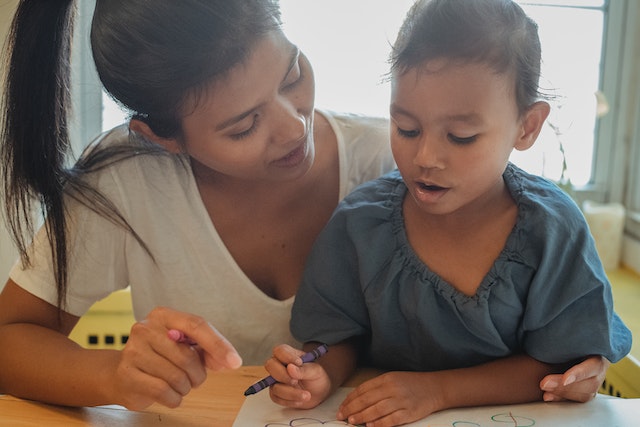Parental engagement and socio-emotional development among children bear a strong influence in building early literacy, reading readiness, and enhancing language skills thru’ expanding vocabulary, but what happens when Parents do not know the second language or have limited knowledge of a second language such as English? How parents without having knowledge of English can contribute to the child’ second early language and literacy development. This article provides insights to parents who are eager to contribute to their developing English as a second language for their children.

In our earlier article, we learned how Literacy development starts early in life and is highly correlated with school achievement. We also learned that without a firm knowledge of letters, children will have difficulty with all other aspects of early literacy. And that teaching letters of the alphabet in isolation, or memorization without understanding, is to be avoided.
One such idea is to introduce alphabet letters to children in a way that the Letters are represented with a range of images experienced by the child. Such customization helps children to learn the language in a personalized and immersive way, and they start to enjoy language in a fun and engaging way.
And finally, when Language learning becomes more immersive by engaging in playful activities and tools, it helps to promote fine motor skills, creativity, brain development & cognitive skills.
Parents’ Role in Supporting Children’s Early Second Language and Literacy Development?
There is strong evidence of the link between parental involvement and children’s early literacy-related development, therefore parents must understand the importance of their role as first teachers and how they can equip themselves with both the skills and the strategies to foster their children’s language and literacy development”. The objective of this article is to help Parents identify easy-to-do activities at home that will yield huge benefits for the Early Second Language & Literacy Development of their children.
What Can Parents Do to Support Children’s Early Language and Literacy Development?
When it comes to first language learning Parental contribution in activities related to areas of oral language and shared reading have shown a substantial positive impact on children’s early language and literacy development.
Parents have many opportunities to support their child’s language development, particularly within the 0-3-8 age group where such engaging activities are shown to have the greatest positive impact.
Children’s first language experiences typically occur at home with their families. Within the meaningful context of natural settings, parents can initiate interactions and respond to their children in ways that boost vocabulary and complex oral language skills. This can be done when parents help to expand on their child’s language and knowledge through conversations. When parents provide a variety of experiences, their child is exposed to words and it’s usage specific to experience or the setting.
Without knowing English, How Can Parents Support Children’s Early Second Language and Literacy Development?
However, when Parents do not know the English language, they can still rely on ‘Wordicons’ to introduce a second language to their children. A Wordicon, which means “Word plus Icon” is a powerful and proven concept that helps a learner to connect a given “icon to a word and to an alphabet letter”. A Wordicon, provides a visual representation of a word in the second language. For example, even without having knowledge of the English language, Parents can see how the icon of Apple is associated to the word Apple which is in-turn is connected to the alphabet letter A.
This concept has been found to be extremely helpful even for capturing a word from any language to help establish connecting a child’s own experience to alphabet letters and words, thus making it a powerful early language and literacy development technique.
Using Wordicons Parents can help to associate “alphabet letter and word” to regular routine activies within the home setting first by using Wordicons to start labeling objects and associating them with alphabet letters. Once a sufficient collection of objects has been associated, it can be said that both Parent and Child have now built substantial vocabulary of English words and are now ready to take the leap forward in learning more.
The building of extensive early vocabulary will help Parents to gradually move to deploy appropriate language skills, and actions and describe what they or their child is doing, thus recasting the child’s words in ways that expand language and apply more complex skills, by asking questions that encourage thinking and talking.
This customized library of words is now ready to serve as valuable personalized reading content thus making a highly effective way for parents to build a child’s vocabulary and cognitive abilities. Following the dialogic reading process, parents can prompt their child with questions, evaluate and expand on the response, provide feedback, and adapt to the child’s interests and abilities. Repeated exposures to the same words allows parents to discuss concepts at new and deeper levels.




